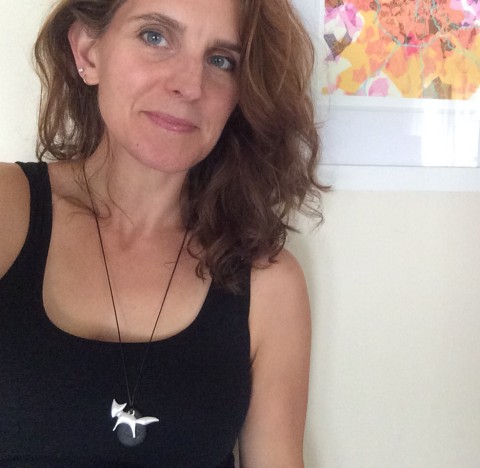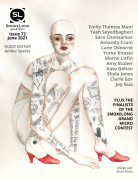The rhythm and pacing of this piece—which is written as a series of run-on sentences with little punctuation—feels purposefully agrammatical and asyntactical, and it reminds me of some of the sections in Faulkner’s As I Lay Dying, especially Darl’s. How did you come to this decision? What does it do for the story and for the protagonist that a more traditional approach wouldn’t?
Wow! Faulkner! I haven’t read him in a long while but I may need to return to his words. I listened to Erik Satie while I wrote this, and his music’s repetition and motifs became a kind of grounding subtext, or an undercurrent I improvised on top of with language. I often start a story with an image to capture emotion, but the plot here, as simple as it is, called for something physical and a little aggressive. The protagonist is a dental hygienist, and the work can be violent and visceral—there’s an odd rhythm to the scraping and the drills while they’re running but the pauses are not musical. So there’s repetition, but it’s off-kilter and surprising, as is the experience of living, as well as the disorienting pause of considering death. There are rules until they disintegrate—that’s what I wanted the writing to do in service of meaning.
You use echoing to great effect in this piece: from the cherry of the teeth cleaning paste to the cherry of the patient’s eyes in the wake of tragedy, from the interlacing of death and the unknotting of divorce to the interlacing of hands during graveside rituals. What do these echoes tell us about the protagonist and her mindset? Do they serve another narrative purpose as well?
I suspect Satie’s constructs contributed to this echoing naturally while I wrote, but certainly for the protagonist, the repetition of daily life exists inside a larger orb of cyclical inevitability. She’s tired and not particularly hopeful, and when she’s nagged by painful memories, like her ex’s favorite candy, she controls them however she can. The image of the car accident site in the snow has a weird, cinematic familiarity and the still lonesomeness and it makes her long for and think about touch—her fingers inside people’s mouths, the lack of physical contact with a lover, the rare times she can hold hands with her grown son. I did write this during the pandemic and the way we lost touch and social ritual likely upset me and came through here.
I read this story three times, and each rereading made me increasingly aware that this is an example of what I like to call the hidden stories of women’s lives, which is both something I admire and that I write about a lot. What I find interesting is that I think this piece would have been far easier to write and make emotionally resonant from the son’s perspective, but you manage to do so beautifully from the mother’s perspective. Why did you choose to tell this story through her eyes?
I’m obsessed with the hidden stories of women’s lives, too, and admire the way you dig into this in your writing! I probably could only have told this from the son’s point of view if I used him as a way to observe his mother. This is her son’s first encounter with death, and it’s raw and innocent—a very different story. I was more interested in considering how the death of these young men compounds the mother’s experiences with grief. I wanted to explore her weariness and lonely anger. All at once she is her teenage self, brushing up against the idea that she and her classmates are not indestructible, her current self and worried about her son, the mothers of all these dead kids, and I imagine she is even able to project into being their grandmothers. I think a lot about how loss affects everyone in a community—not just immediate family members and friends.
I kept coming back to the title of this piece—low pink star. It suggests to me something both deeply loving and profoundly distant in the relationship between mother and son, and it hints at a bigger world beyond the frame of the story. Why did you choose this as the title? If you could project ten years into the future for this family, what might we see as readers?
If red represents the ex-husband, pink became the color of the tender offspring. I’m not sure if the star is rising or setting, but for her, it’s constant and won’t leave. It’s fixed. I wanted to play with the cliché of mothers revolving around their male offspring, and consider how raising the sons of disappointing men is heavy stuff—all of that is baked into the title, although it came after the story was finished. Hmm … I’ll stay true to my cautious optimism and say in ten years she’s remarried to her favorite patient who surprisingly charmed her by making corny Dad jokes while she cleaned his teeth, and her son has been in a serious non-fatal car accident (because these things come in threes) but he’s okay, and his wife is pregnant with their first child.
This piece carries so much varied emotional weight—from grief to pain to humor to love. Who are the flash writers or fiction writers who inspire you? Is there anyone else doing this kind of work that you particularly love?
I’m happy you found some humor in here, because it doesn’t come easily for me while I lean towards bittersweet realizations. I do love novelists who do balance the serious with sarcasm and dry humor like Marcy Dermansky, Mirian Towes, and Kevin Wilson. I lap up flash fiction by writers like Sara Lippmann, Meghan Phillips, Jennifer Wortman, and Ruth LeFaive, who all write women’s lives with inventive beauty.



 The core workshop of SmokeLong Fitness is all in writing, so you can take part from anywhere at anytime. We are excited about creating a supportive, consistent and structured environment for flash writers to work on their craft in a community. We are thrilled and proud to say that our workshop participants have won, placed, or been listed in every major flash competition. Community works.
The core workshop of SmokeLong Fitness is all in writing, so you can take part from anywhere at anytime. We are excited about creating a supportive, consistent and structured environment for flash writers to work on their craft in a community. We are thrilled and proud to say that our workshop participants have won, placed, or been listed in every major flash competition. Community works.